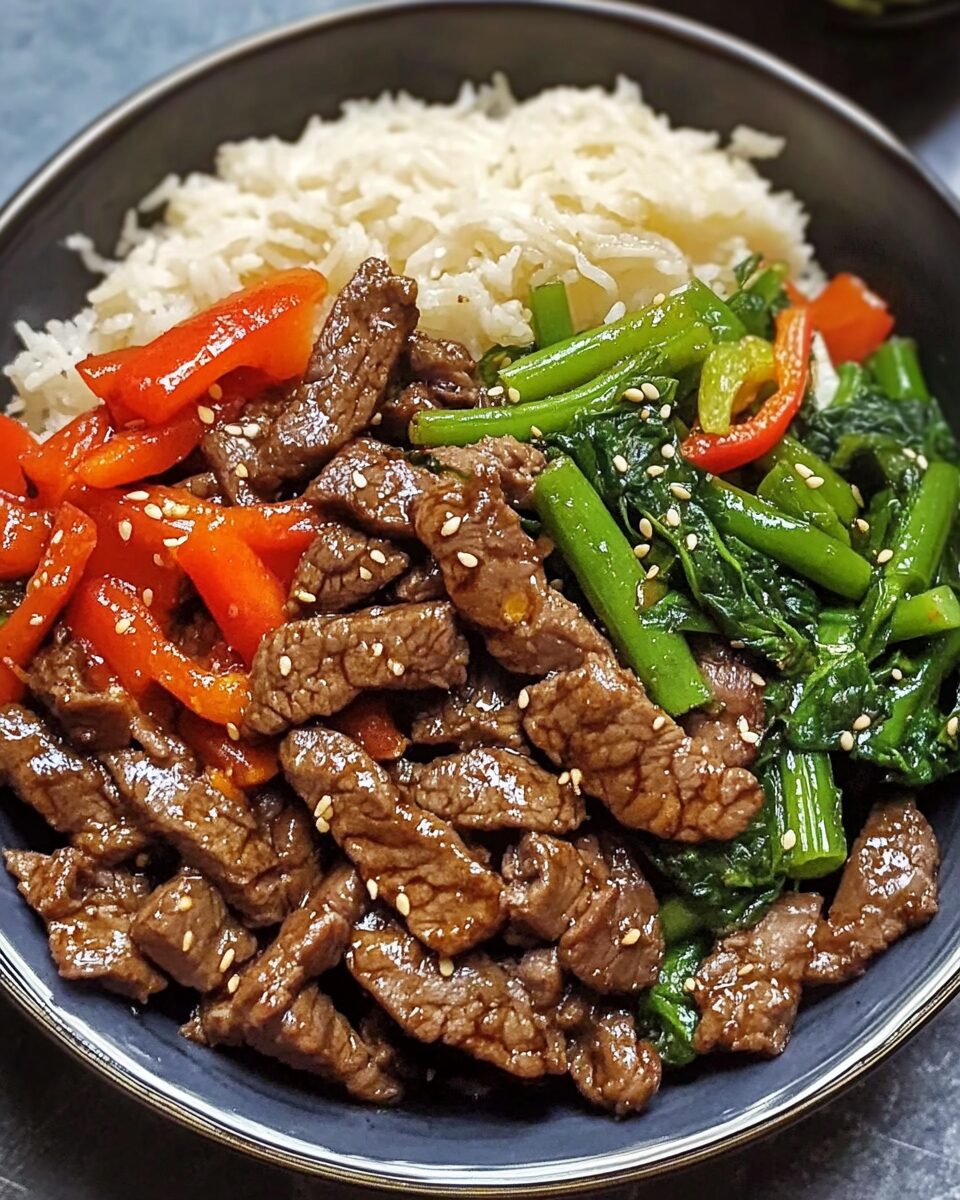This Healthy Mongolian Beef is a delightful twist on the classic takeout favorite. Featuring tender slices of beef coated in a rich, savory sauce, paired with crisp broccoli and carrots, it’s a dish that brings restaurant-quality flavors right to your kitchen.
Not only is this recipe quick and easy to prepare, but it’s also a healthier alternative to the traditional version, using less oil and low-sodium soy sauce. Serve it over steamed rice or quinoa for a wholesome and satisfying meal that’s perfect for busy weeknights or meal prep.
Full Recipe:
Ingredients:
- 1 pound (450 g) flank steak, thinly sliced
- 1/4 cup cornstarch
- 1/3 cup low-sodium soy sauce
- 1/4 cup brown sugar
- 2 cloves garlic, minced
- 1 tablespoon fresh ginger, grated
- 1/2 cup water
- 2 tablespoons vegetable oil
- 1/4 teaspoon red pepper flakes (optional)
- 1 cup broccoli florets
- 1 cup carrots, julienned
- 2 green onions, sliced
- Sesame seeds for garnish
Directions:
- Lightly coat the flank steak slices in cornstarch, shaking off any excess. Set aside.
- In a small bowl, whisk together soy sauce, brown sugar, garlic, ginger, and water. Set the sauce aside.
- Heat 1 tablespoon of vegetable oil in a large skillet or wok over medium-high heat. Cook the steak slices in batches until browned, about 2 minutes per side. Remove the steak and set aside.
- In the same skillet, add the remaining oil. Sauté the broccoli and carrots for 3-4 minutes until tender-crisp.
- Add the sauce mixture to the skillet and bring to a simmer. Let the sauce thicken for about 2 minutes.
- Return the cooked steak to the skillet and toss to coat in the sauce. Cook for 1-2 minutes, ensuring the beef and vegetables are well combined.
- Sprinkle with green onions and sesame seeds before serving.
Prep Time: 15 minutes | Cooking Time: 15 minutes | Total Time: 30 minutes
Kcal: 310 kcal | Servings: 4 servings
Origins and Background of Mongolian Beef
Mongolian Beef, despite its name, does not originate from Mongolia. It is a popular dish in Chinese-American cuisine, typically served in Chinese restaurants across the world. The dish is inspired by Mongolian barbecue, a stir-fry cooking style from Taiwan that involves quickly cooking meats and vegetables over high heat. This healthier version retains the bold flavors of the original dish while focusing on fresh ingredients and reduced sodium, making it suitable for a health-conscious audience.
Nutritional Highlights
This recipe is designed with health in mind:
- Low in Sodium: By using low-sodium soy sauce, this dish reduces the typical salt content without compromising on flavor.
- High in Protein: Flank steak is an excellent source of protein, helping to keep you fuller for longer and support muscle repair.
- Rich in Vegetables: With the inclusion of broccoli and carrots, this dish offers a healthy dose of fiber, vitamins, and minerals like Vitamin C and potassium.
- Lower Calorie Alternative: By minimizing the use of oil and sugar, this recipe keeps the calorie count moderate, making it a guilt-free indulgence.
Cooking Tips and Variations
- Vegetable Substitutions: Feel free to swap broccoli and carrots for your favorite vegetables like snap peas, bell peppers, or zucchini.
- Vegan Option: Replace the beef with tofu or seitan and use a vegan soy sauce alternative to make this dish plant-based.
- Spicy Kick: Add a teaspoon of sriracha or chili paste to the sauce for a spicier version of this dish.
- Thicker Sauce: If you prefer a thicker sauce, mix 1 teaspoon of cornstarch with 2 tablespoons of water and stir it into the sauce during cooking.
Serving Suggestions
- Pair this Mongolian Beef with a bowl of steamed jasmine rice, brown rice, or cauliflower rice for a low-carb option.
- Add a side of stir-fried greens like bok choy, kale, or spinach to enhance the meal’s nutritional profile.
- Sprinkle sesame seeds and additional green onions as garnish to add extra texture and flavor.
Storage and Meal Prep
This dish is perfect for meal prepping:
- Refrigeration: Store leftovers in an airtight container in the refrigerator for up to 3 days.
- Reheating: Gently reheat the beef and vegetables in a skillet over medium heat to retain the texture and flavor.
- Freezing: You can freeze the cooked beef and sauce separately from the vegetables for up to 2 months. Add fresh vegetables when reheating for the best texture.
Why You’ll Love This Recipe
- Quick and Easy: Ready in just 30 minutes, this is perfect for busy weeknights.
- Customizable: Adjust the level of sweetness, spice, or add more vegetables to suit your taste.
- Restaurant-Quality: The rich, savory sauce brings authentic flavors to your dinner table without the need for takeout.
Why Choose Healthy Mongolian Beef?
Mongolian Beef is a classic favorite for its bold, savory flavors. This healthier version allows you to enjoy the richness of the dish without the excessive calories and sodium often found in restaurant versions. With its quick preparation time and fresh, nutrient-packed ingredients, this recipe is perfect for busy families, health-conscious individuals, and anyone who loves Asian-inspired meals.
Health Benefits of the Ingredients
- Flank Steak:
- A lean cut of beef rich in protein, iron, and B vitamins.
- Supports muscle growth and boosts energy levels.
- Broccoli:
- A superfood packed with fiber, Vitamin C, and antioxidants.
- Promotes immune health and aids digestion.
- Carrots:
- High in beta-carotene, which converts to Vitamin A.
- Supports vision, skin health, and overall wellness.
- Garlic and Ginger:
- Both are known for their anti-inflammatory and immune-boosting properties.
- Add depth and aroma to the dish while enhancing its health profile.
- Low-Sodium Soy Sauce:
- A healthier alternative to traditional soy sauce, reducing the overall salt content without sacrificing flavor.
How This Recipe is Made Healthier
- Cornstarch Coating: Instead of deep-frying the beef, it’s lightly coated in cornstarch and stir-fried in minimal oil, reducing unnecessary fat.
- Natural Sweeteners: Using brown sugar in moderate amounts provides a touch of sweetness without being overpowering.
- Fresh Veggies: Broccoli and carrots are included to add fiber, crunch, and essential nutrients, turning this into a balanced one-pan meal.
Cooking Techniques for Perfect Results
- Slicing the Beef:
- To ensure tender bites, slice the beef thinly against the grain. This cuts through the muscle fibers and keeps the meat tender during cooking.
- Stir-Fry on High Heat:
- Cooking on high heat allows the beef to sear quickly, locking in juices and enhancing flavor.
- Add the sauce and vegetables in the final minutes for a perfectly combined dish.
- Let the Sauce Thicken Naturally:
- The cornstarch coating on the beef helps the sauce thicken as it cooks. No need for extra thickeners!
Cultural and Culinary Inspiration
Although Mongolian Beef doesn’t hail directly from Mongolia, it’s deeply inspired by East Asian flavors and cooking styles. The combination of sweet, savory, and umami flavors is iconic in Chinese-American cuisine, making it a beloved dish for decades. This recipe pays homage to those rich traditions while adapting it for modern, healthier eating habits.
Pairing Suggestions
- Side Dishes: Serve with jasmine rice, brown rice, or even quinoa for a hearty, balanced meal. For a low-carb option, pair it with cauliflower rice or zucchini noodles.
- Beverages: Pair this dish with a refreshing iced green tea, jasmine tea, or sparkling water with a hint of lime.
- Appetizers: Complement the meal with spring rolls, dumplings, or a light cucumber salad.
Audience Appeal
- Busy Professionals: A quick 30-minute recipe perfect for weeknight dinners.
- Families: Loved by both adults and kids for its sweet-savory flavor profile.
- Health Enthusiasts: A lower-calorie, nutrient-packed alternative to takeout Mongolian Beef.
Fun Fact
The term “Mongolian” in the dish name is believed to evoke a sense of exotic Asian flavors rather than referring to an actual Mongolian cuisine. This makes it a fascinating example of how dishes evolve in name and style as they travel across cultures.
Common Questions
Q: Can I make this recipe gluten-free? A: Absolutely! Use tamari or coconut aminos instead of soy sauce, and ensure your cornstarch is gluten-free.
Q: Can I meal-prep this recipe? A: Yes! Cook and store the beef and vegetables separately. Combine and reheat when ready to serve to retain the fresh texture of the vegetables.
Q: What if I don’t eat beef? A: Substitute with chicken, turkey, or even tofu for a plant-based alternative. Adjust the cooking time to suit your protein of choice.

